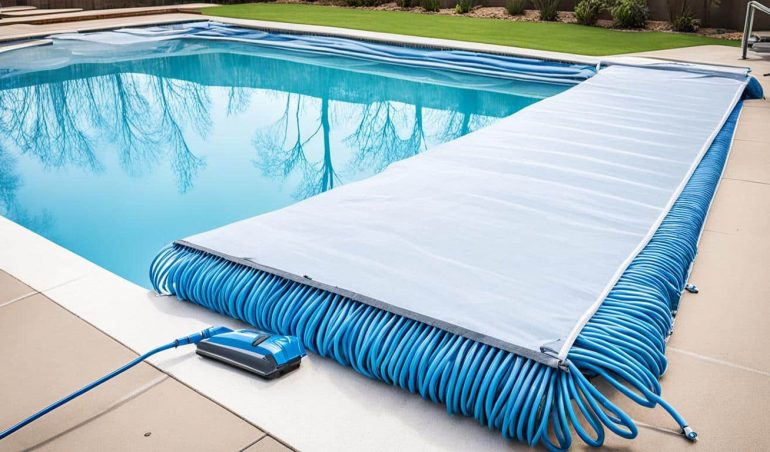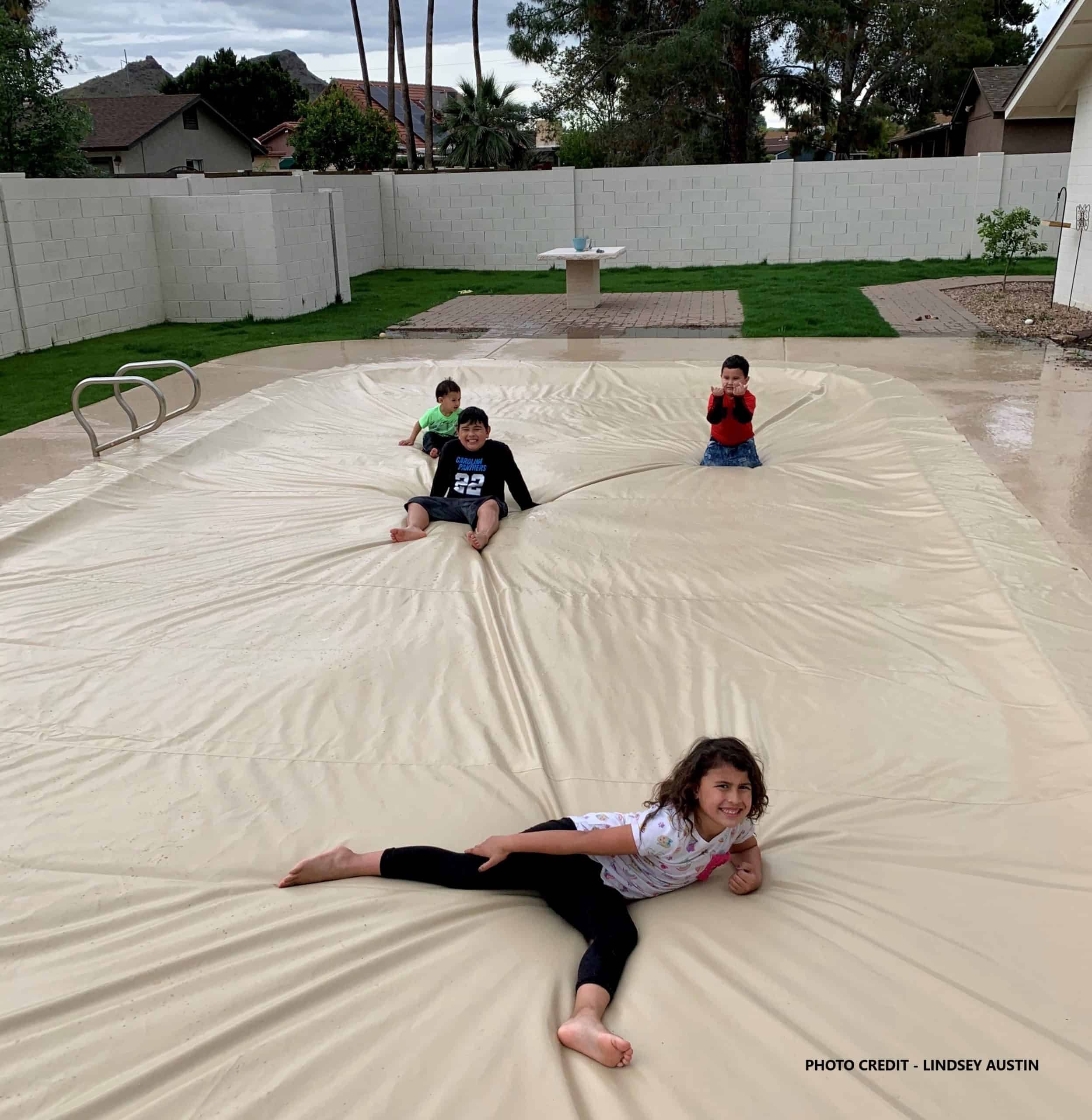In this article from our experience, we will discuss the essential steps you need to take to prepare your pool for a cover. Proper preparation ensures the longevity of your pool cover while keeping your pool clean and safe for future use.
When it comes to pool cover maintenance, taking the right steps before covering your pool can make a significant difference. By following these necessary precautions, you can ensure the protection and longevity of your pool cover, saving yourself time and money in the long run.
Key Takeaways:
- Proper preparation is essential for the longevity of your pool cover.
- Cleaning the pool and clearing debris before covering is crucial.
- Lowering the water level helps prevent damage to the pool cover.
- Winterizing pool equipment protects it from freezing temperatures.
- By following these steps, you can maintain a clean and safe pool for seasons to come.
Clearing Debris and Cleaning the Pool
Before you can cover your pool, it’s important to prioritize pool cleanliness. Clearing debris and cleaning the pool thoroughly is essential for maintaining a clean, safe pool environment. By taking the time to remove leaves, twigs, and other debris from the water and pool surfaces, you can prevent potential damage to your pool cover and promote water clarity.
Start by skimming the pool’s surface with a net to remove any floating debris. This will help prevent it from sinking to the bottom of the pool and making cleaning more challenging. Take extra care to skim the entire surface, paying attention to areas around trees, bushes, or other objects that may shed leaves or other debris.
Once you have cleared the surface, proceed to brush the pool walls and steps. This helps remove any algae or buildup that has accumulated. Use a pool brush with firm bristles and scrub thoroughly, paying attention to corners and hard-to-reach areas.
Next, it’s time to vacuum the bottom of the pool. Use either a manual vacuum cleaner or an automatic pool cleaner, depending on your preference and equipment availability. Move the vacuum methodically across the pool, overlapping each pass to ensure comprehensive coverage. Focus on areas that may collect more debris, such as corners or near pool features.
As you clean, it’s crucial to monitor and maintain proper water chemistry. Test the water using a pool water testing kit to ensure the pH, chlorine, and other chemical levels are balanced. Adjust as necessary to keep the water clean and safe for swimming.
Remember, a clean pool not only promotes a healthier swimming environment but also reduces the workload on your pool cover. By removing debris and maintaining proper pool hygiene, you can effectively prepare your pool for cover installation and extend the lifespan of both your pool and cover.
| Debris Removal Tips |
|---|
| Skim the pool’s surface with a net to remove floating debris. |
| Use a pool brush with firm bristles to thoroughly brush the pool walls and steps. |
| Vacuum the bottom of the pool using a manual or automatic cleaner. |
| Monitor and balance water chemistry to maintain a clean pool. |
Lowering the Water Level
Before covering your pool, it is essential to lower the water level to prevent overflow and potential damage to the pool cover. This step is particularly important during heavy rains or snowfall when the water level can rise rapidly.
To ensure the proper preparation of your pool for a cover, follow these steps to safely lower the water level:
- Turn off the pool pump to stop water circulation.
- Remove any debris or leaves from the water surface using a skimmer net.
- Attach a pool hose to the pool’s waste outlet or drain valve.
- Place the other end of the hose in a suitable drainage area away from the pool.
- Open the waste outlet or drain valve to start draining the water.
- Monitor the water level closely to ensure it reaches the recommended height for covering.
- If needed, adjust the drainage rate by partially closing the waste outlet or drain valve.
It’s important to note that the recommended water level for covering your pool may vary depending on factors such as the type of pool cover and the climate in your area. Generally, the water level should be lowered to about one-third below the skimmer level.
By following these steps to lower the water level in your pool before covering it, you can protect your pool cover from potential damage and ensure its longevity.
| Step | Description |
|---|---|
| 1 | Turn off the pool pump to stop water circulation. |
| 2 | Remove any debris or leaves from the water surface using a skimmer net. |
| 3 | Attach a pool hose to the pool’s waste outlet or drain valve. |
| 4 | Place the other end of the hose in a suitable drainage area away from the pool. |
| 5 | Open the waste outlet or drain valve to start draining the water. |
| 6 | Monitor the water level closely to ensure it reaches the recommended height for covering. |
| 7 | If needed, adjust the drainage rate by partially closing the waste outlet or drain valve. |
Winterizing Pool Equipment
When preparing your pool for the winter months, it’s crucial to take the necessary steps to protect your pool equipment from freezing temperatures. Proper winterization will ensure the longevity and functionality of your equipment, saving you costly repairs in the future.
Draining Water from Pipes
Start by draining all water from your pool’s pipes and plumbing system. Any remaining water can freeze and cause damage. To do this, turn off the pump and filter system, open the drain plugs on the pump, filter, and heater, and let the water drain completely.
Removing and Storing Fragile Components
Next, carefully remove any fragile components from your pool equipment. This includes items such as pool skimmer baskets, pool filters, and pool pumps. Clean and inspect these components for any damage or wear, and store them in a dry and safe location for the winter.
Adding Antifreeze to the System
In areas where temperatures regularly drop below freezing, adding antifreeze to your pool’s plumbing system is a recommended step. This will provide an extra layer of protection against freezing and potential damage. Consult your pool manufacturer’s guidelines or a professional for the appropriate type and amount of antifreeze to use.
By winterizing your pool equipment, you are taking proactive measures to protect your investment. This ensures that when the warmer months return, your pool will be ready for use, and your equipment will be in excellent condition. Remember, proper maintenance and preparation lead to a longer lifespan for your pool equipment and a stress-free pool experience in the future.
| Winterizing Pool Equipment Checklist |
|---|
| 1. Drain water from pipes and plumbing system |
| 2. Remove and store fragile components |
| 3. Add antifreeze to the system (if necessary) |
Conclusion
Now that you have learned the essential steps to prepare your pool for a cover, you can ensure the longevity of your pool cover and maintain a clean, safe pool for seasons to come. By following these steps, you are protecting your investment and saving yourself from potential costly repairs.
Firstly, clearing debris and cleaning the pool thoroughly is crucial. Remove leaves, twigs, and any other debris from the water and surfaces. Brush the pool walls, vacuum the bottom, and balance the water chemistry to keep your pool clean.
Secondly, lowering the water level is necessary to prevent overflow and potential damage. This step safeguards the pool cover during heavy rains or snowfall. Follow the recommended water level and safely lower it to protect your pool.
Lastly, don’t forget to winterize your pool equipment. This is essential to protect it from freezing temperatures and potential damage during the colder months. Drain water from the pipes, remove and store fragile components, and consider adding antifreeze if needed.
By incorporating these steps into your pool maintenance routine, you can enjoy a hassle-free pool experience and extend the lifespan of your pool cover. Remember to clear debris, clean the pool, lower the water level, and winterize your equipment before covering it. With proper preparation, your pool will be ready for the next season, saving you time, money, and ensuring a clean, safe swimming environment.
FAQ
How do I prepare my pool for a cover?
To prepare your pool for a cover, you should start by clearing debris and cleaning the pool thoroughly. This includes removing leaves, twigs, and any other debris, brushing the pool walls, vacuuming the bottom, and balancing the water chemistry. Additionally, you should lower the water level to prevent overflow and winterize your pool equipment to protect it from freezing temperatures.
Why is it important to clear debris and clean the pool before covering it?
Clearing debris and cleaning the pool before covering it is crucial to maintain a clean and safe pool. By removing leaves, twigs, and other debris, you prevent them from decomposing in the water and potentially causing contamination. Cleaning the pool walls and vacuuming the bottom eliminates any dirt or algae buildup, ensuring a fresh start when you uncover the pool in the future.
How do I lower the water level in my pool?
Lowering the water level in your pool is essential to prevent overflow and potential damage to the cover during heavy rainfall or snowfall. You can lower the water level by using a submersible pump or siphoning off the excess water. It is recommended to maintain the water level below the skimmer mouth but above the pool’s bottom drains.
Why is it necessary to winterize pool equipment?
Winterizing pool equipment is necessary to protect it from freezing temperatures, which can cause damage. By draining water from pipes, removing and storing fragile components such as filters and pumps, and adding antifreeze to the system if required, you ensure that your pool equipment remains in good condition during the colder months.
What are the benefits of preparing my pool for a cover?
Preparing your pool for a cover has several benefits. It helps prolong the lifespan of the pool cover, protects the pool from debris and contamination, and prevents potential damage caused by freezing temperatures. Additionally, proper pool preparation saves you from costly repairs and ensures a hassle-free pool experience when you reopen it in the future.






